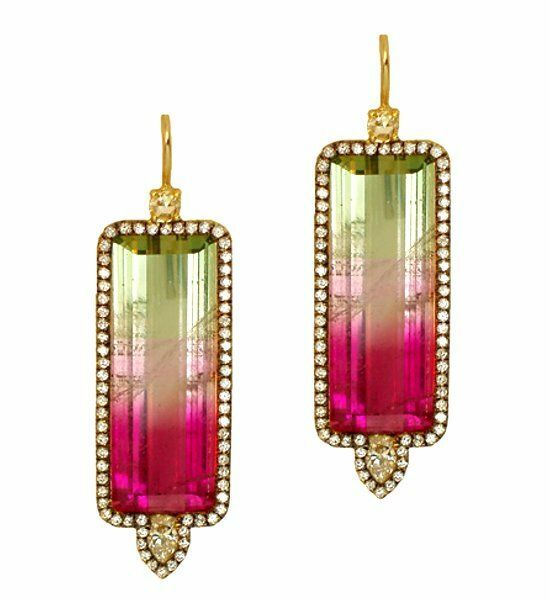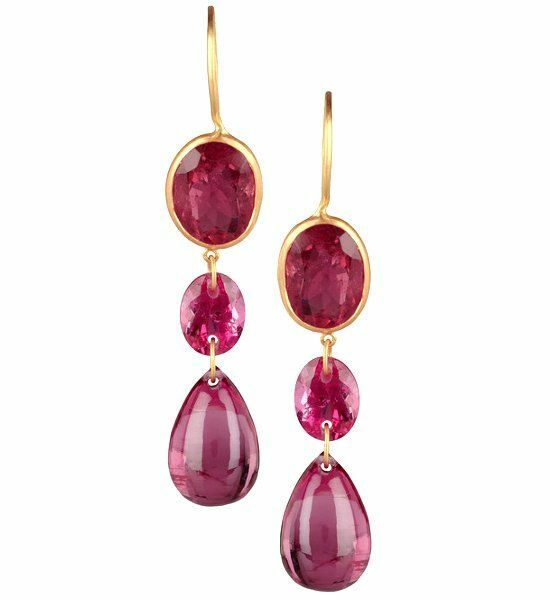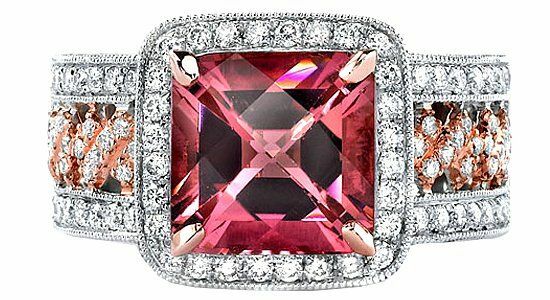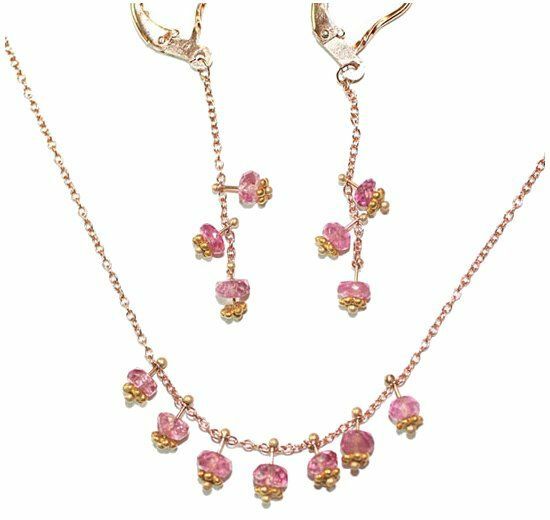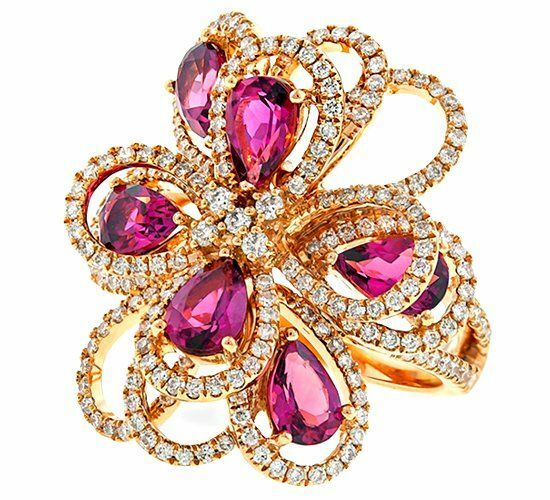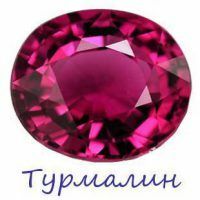
Tourmaline is one of the most beautiful stones among gems. In ancient times this mineral was attributed to magical properties, and modern scientists refer it to the number of healers.
- Stone history
- Turmaline deposits
- Mineral description
- Varieties of tourmaline
- Chemical composition and physical properties of the stone
- The healing properties of the tourmaline
- The magical properties of the mineral
- Tourmaline and the zodiac signs
- The use of tourmaline
- Interesting facts about the stone
- How to distinguish the natural tourmaline from a counterfeit
- Pictures of stone products tourmaline
History of stone
Unusual properties of tourmaline, in particular, its attractivenesss dust and ashes, have been seen in ancient times. No wonder it was called a magnet stone and was considered magical. He was called the symbol of faith, wisdom and spiritual quest.
Valued tourmaline for its extraordinary beauty, and for a variety of color shades. For example, the Egyptians called tourmaline "the precious stone of the rainbow", believing in the legend that he came to Earth from the very Sun, and on the way absorbed all the beautiful colors of the rainbow.
In the ΧΙΙ century, gold-trimmed exquisite jewelry from this mineral was also made in Byzantium.
In the 5th century the tourmaline was recognized and loved in Russia, having acquired the skills of Byzantine masters.
And here in Europe this beautiful gem fell only in 1703, thanks to the Dutch sailors who brought it from Ceylon. Since then, he took a worthy place among the precious stones and even served as an ornament of jewelry belonging to the crowned people.
back to contents ^Tourmaline deposits
Today different species of tourmalines are mined in many countries. The largest and most famous deposits of this gem are in Brazil and Mozambique, Burma and Angola, Sri Lanka and Madagascar, Australia, India, South Africa, Canada, the USA and Russia.
to contents ^Description of mineral
Tourmaline is not just one stone, but a whole subgroup of minerals similar in composition and structure and belonging to a group of boron-containing aluminosilicates.
"Electrical Mineral" - that's what tourmaline Pierre Curie and Marie Sklodowska-Curie called, finding in it the presence of a constant electric charge, whose radiation at its power( 0.06 mA) corresponds to the radiation of cells of the human body.
Externally, tourmaline crystals are convex triangular elongated prisms with characteristic glass shine and longitudinal pronounced shading along their main axis.
The name "tourmaline" comes from the Sinhalese "tourmal", which in translation means "a magical multi-colored stone".
And indeed, these gems surprise with a variety of their colors.
to table of contents ^Tourmaline species
Tourmalines are many-sided, like no other gem. There are about fifty of their shades. They are both pink, and dark blue, and turquoise, and black.
Each of these species of tourmaline has its name:
- pink-red - rubellite;
- dark blue - indigolite;
- dark green - verdelit;
- colorless - achroit;
- brownish-yellow - dravit;
- turquoise green - paraiba;
- emerald - chrome-tourmaline ;
- black - sherle.
An interesting species of tourmaline is the chameleonite. It changes color according to the lighting. So, with artificial lighting, it is brownish-red, with daylight - olive-green.
There are also polychrome species of tourmaline, combining several colors. They are most appreciated, as, however, and transparent tourmaline crimson, red, green and blue.
The color of this amazing gem directly depends on its chemical composition.
to contents ^Chemical composition and physical properties of
stone As part of tourmaline - more than 25 trace elements from Mendeleyev's table, including:
- iron;
- potassium;
- silicon;
- calcium;
- iodine;
- magnesium;
- manganese;
- fluorine, etc.
The main feature of this boron-containing aluminosilicate is its variable chemical composition.
All tourmalines have a sufficiently high hardness( 7-7.5 on the Mohs scale) and density( 3-3.25 g / cm3).
The peculiarity of the crystals of tourmaline is their asymmetric faceting from different ends( hemimorphism), due to which their special pyro- and piezoelectric properties are manifested.
It is thanks to these properties that today tourmaline is actively used for healing.
to contents ^Therapeutic properties of tourmaline
The piezoelectric properties of these minerals manifest themselves in their ability to heat( solar or heat of the human body), form negative electric charges. These electrical charges, connecting with oxygen atoms, form negative aeroions - unique particles that activate the energy capabilities of the body.
Scientists have proven that air ions have a positive effect on:
- hematopoiesis,
- blood sugar;
- blood pressure;
- tissue respiration;
- the work of the nervous system;
- body temperature;
- metabolism.
Aeroions have an effect on all the basic physico-chemical processes that occur in the body.
Under their action in the human body, the following changes occur:
- local blood flow improves;
- is strengthened by immunity;
- hormone and endocrine systems are restored;
- is enhanced by cellular metabolism;
- improves nutrition in organs and tissues;
- restores the lymphatic system;
- improves metabolism;
- improves memory;
- restores sleep;
- improves complexion;
- restores the sexual function of the body;
- improves potency;
- is recovered from stressful situations by the nervous system;
- fades away dizziness;
- relieves headaches;
- improves eyesight.
During heating, tourmalines emit thermal long-wave infrared rays with a range of 6-14 microns, corresponding to weak currents flowing in the human body. The Japanese call them "the rays of life."These rays help restore the energy balance of a person.
Due to the high bioenergetic activity in alternative medicine, tourmaline is actively used in:
- infectious diseases;
- oncological diseases;
- diseases of the nervous system;
- diseases of the endocrine system;
- decreased immunity;
- metabolic disorders;
- blood diseases;
- of prostate disease;
- sexual impotence;
- diseases of endocrine glands
- sleep disorders;
- Mental Disorders.
It is believed that tourmaline can neutralize negative emotions, promote muscle relaxation, relieve stress and tension.
Attributed to this stone and magical properties.
to contents ^Magic properties of mineral
According to popular beliefs, tourmaline is a spiritual stone capable of awakening creative forces and hidden talents in a person. Most of all, this statement applies to green tourmalines. But the black stones of this group of minerals have been attributed from time to time properties to attract dark forces. No wonder they were used for witchcraft.
Made from tourmaline and talismans.
It is believed that the talisman of tourmaline is capable of:
- strengthen the body and mind;
- eliminate fear and anxiety;
- contribute to the preservation of prosperity in the home;
- bring success in your personal life;
- save youth;
- to strengthen love and friendship.
Tourmaline and zodiac signs
Astrologers say that tourmaline is the most suitable:
- to Lviv;
- Capricorn;
- to Scorpions,
- to Sagittarius.
It is to these signs of the zodiac that the stone helps to develop their latent abilities, they protect them from dependence( narcotic and alcoholic).
to contents ^Application of tourmaline
Due to its special properties, tourmaline minerals are used in many areas:
- in medicine;
- in radio engineering;
- in the jewelry business.
Depending on the characteristics of the color and the degree of transparency, tourmaline is divided into precious and ornamental stones.
The criterion for evaluating their quality is the brightness and color saturation of the crystal, as well as the presence of defects in it.
to the table of contents ^Interesting facts about the stone
The average price of tourmalines in the world market ranges from 20 to 50 dollars per carat, although among them there are also very valuable specimens, the most expensive among the gems. So, a tourmaline good quality paribe can cost up to 6 thousand dollars per carat.
The best representative of this group of minerals is the "Merry Green Giant" - an impressive size tourmaline, which can be seen at the New York State Museum of Natural History.
Tourmalines are often confused with other precious stones. Thus, recognized as the world's largest ruby, which was inlaid with the crown of the famous dynasty of Czech kings, turned out to be a tourmaline of red color. As, however, and the famous "Grapes bunch", presented to Catherine II by the Swedish king.
to the table of contents ^How to distinguish natural tourmaline from forgery
Tourmalines falsify quite often, offering instead of natural stones imitations from the most common glass and synthetic analogues of gems.
You can make sure of the naturalness of the mineral in several ways:
- Test it for strength by trying to scratch it. Tourmaline is a very hard mineral, twice as strong as glass, so you can not scratch anything on it.
- Pay attention to the game of light. Natural tourmaline is characterized by birefringence and strong pleochroism.
- Make sure that the mineral is electrified by doing a small experiment. When heated, the natural gem begins to become electrified. Try it at a time when it will become warm, bring to it small pieces of paper. If they start to attract - it's definitely not fake before you. Electrification is the main feature of tourmaline.
Pictures of stone products tourmaline
